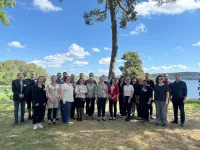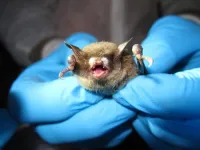(Press-News.org) Image
The flow of water within a muscle fiber may dictate how quickly muscle can contract, according to a University of Michigan study.
Nearly all animals use muscle to move, and it's been known for a long time that muscle, like all other cells, is composed of about 70% water. But researchers don't know what sets the range and upper limits of muscle performance. Previous research into how muscle works focused only on how it worked on a molecular level rather than how muscle fibers are shaped, that they are three-dimensional and are full of fluid.
U-M physicist Suraj Shankar together with L. Mahadevan, a professor of physics at Harvard University, created a theoretical model of water's role in muscle contraction and found that how fluid moves through a muscle fiber determines how quickly a muscle fiber can contract.
They also found that muscle exhibits a new kind of elasticity called odd elasticity that allows muscle to generate power using three dimensional deformations, shown in a common observation that when a muscle fiber contracts lengthwise, it also bulges perpendicularly.
The researchers say this framework can be used to describe many other cells and tissues, which are also largely composed of water, and can be applied to the ultrafast movements of unicellular microorganisms and how they can be controlled. Their findings could also impact the design of soft actuators (a type of material that converts energy into motion), fast artificial muscles, and shape-morphing materials, all of which have very slow contraction speeds because they are triggered externally. Their results are published in the journal Nature Physics.
"Our results suggest that even such basic questions as how quickly muscle can contract or how many ways muscle can generate power have new and unexpected answers when one takes a more integrated and holistic view of muscle as a complex and hierarchically organized material rather than just a bag of molecules," Shankar said. "Muscle is more than the sum of its parts."
The researchers envision each muscle fiber as a self-squeezing active sponge, a water-filled, sponge-like material that can contract and squeeze itself through the action of molecular motors, he says.
"Muscle fibers are composed of many components, such as various proteins, cell nuclei, organelles such as mitochondria, and molecular motors such as myosin that convert chemical fuel into motion and drive muscle contraction," Shankar said. "All of these components form a porous network that is bathed in water. So an appropriate, coarse-grained description for muscle is that of an active sponge."
But the squeezing process takes time to move water around, so the researchers suspected that this movement of water through the muscle fiber set an upper limit on how rapidly a muscle fiber can twitch.
To test their theory, they modeled muscle movements in multiple organisms across mammals, insects, birds, fish and reptiles, focusing on animals that use muscles for very fast motions. They found that muscles that produce sound, such as the rattle in a rattlesnake's tail, that can contract ten to hundreds of times per second typically don't rely on fluid flows. Instead, these contractions are controlled by the nervous system and are more strongly dictated by molecular properties, or the time it takes for molecular motors within cells to bind and generate forces.
But in smaller organisms, such as flying insects who are beating their wings a few hundred to a thousand times per second, these contractions are too fast for neurons to directly control. Here fluid flows are more important.
"In these cases, we found that fluid flows within the muscle fiber are important and our mechanism of active hydraulics is likely to limit the fastest rates of contraction," Shankar said. "Some insects such as mosquitos seem to be close to our theoretically predicted limit, but direct experimental testing is needed to check and challenge our predictions."
The researchers also found that when muscle fibers act as an active sponge, the process also causes the muscles to act as an active elastic engine. When something is elastic, such as a rubber band, it stores energy as it tries to resist deformation. Imagine holding a rubber band between two fingers and pulling it back. When you release the rubber band, the band also releases the energy stored when it was being stretched. In this case, energy is conserved—a basic law of physics that dictates that the amount of energy within a closed system should remain the same over time.
But when muscle converts chemical fuel into mechanical work, it can produce energy like an engine, violating the law of the conservation of energy. In this case, muscle shows a new property called "odd elasticity", where its response when squashed in one direction versus another is not mutual. Unlike the rubber band, when muscle contracts and relaxes along its length, it also bulges out perpendicularly, and its energy does not stay the same. This allows muscle fibers to generate power from repetitive deformations, behaving as a soft engine.
"These results are in contrast to prevailing thought, which focuses on molecular details and neglects the fact that muscles are long and filamentous, are hydrated, and have processes on multiple scales," Shankar said. "All together, our results suggest a revised view of how muscle functions is essential to understand its physiology. This is also crucial to understanding the origins, extent and limits that underlie the diverse forms of animal movement."
Study: Active hydraulics and odd elasticity of muscle fibers
END
Muscle machine: How water controls the speed of muscle contraction
2024-07-11
ELSE PRESS RELEASES FROM THIS DATE:
Nearly one in 10 pregnant people who get COVID will develop long COVID
2024-07-11
Nearly one in 10 people who get COVID while pregnant will go on to develop long COVID, a report publishing July 11th in Obstetrics & Gynecology has found.
“It was surprising to me that the prevalence was that high,” says Torri Metz, MD, vice chair of research of obstetrics and gynecology at University of Utah Health, who co-led the nationwide study. “This is something that does continue to affect otherwise reasonably healthy and young populations.”
Intersecting risks
Prior research had shown that COVID affects pregnant people in uniquely ...
User control of autoplay can alter awareness of online video ‘rabbit holes’
2024-07-11
UNIVERSITY PARK, Pa. — The rabbit hole contains madness, according to author Lewis Carroll. Online, that madness manifests in the form of increasingly extreme content, often without users realizing it. A new study by Penn State researchers suggests that giving users control over the interface feature of autoplay can help them realize that they are going down a rabbit hole.
The work — which the researchers said has implications for responsibly designing online content viewing platforms and algorithms, as well as helping users better ...
UCF launches inaugural mentorship, scholarship initiative for students in AI
2024-07-11
VIDEO: https://www.youtube.com/watch?v=6j4zjqI21Gs
Faculty in UCF’s College of Sciences and College of Engineering and Computer Science are preparing incoming students to keep pace with the emerging multidisciplinary field of artificial intelligence.
A team of five faculty, led by UCF’s Center for Research in Computer Vision (CRCV), recently received a U.S. National Science Foundation grant totaling nearly $2.5 million over five years to serve as resources to uplift bright yet low-income or struggling ...
Ultrasound technology can be used to boost mindfulness, study finds
2024-07-11
One of the intriguing abilities of the human mind is daydreaming, where the mind wanders off into spontaneous thoughts, fantasies and scenarios, often without conscious effort, allowing creativity and reflection to flow freely.
In a new study published in Frontiers of Human Neuroscience, University of Arizona researchers used low-intensity ultrasound technology to noninvasively alter a brain region associated with activities such as daydreaming, recalling memories and envisioning the future. They found that the technique can ultimately enhance mindfulness, marking a major advancement in the field ...
Gravitational waves hint at dark matter and Big Bang mysteries
2024-07-11
RIVERSIDE, Calif. -- Gravitational Waves, ripples in space-time predicted by Einstein almost a century ago, were detected for the first time in 2015. A new study led by Yanou Cui, an associate professor of physics and astronomy at the University of California, Riverside, reports that very simple forms of matter could create detectable gravitational wave backgrounds soon after the Big Bang.
“This mechanism of creating detectable gravitational wave backgrounds may shed light on ...
Study identifies seductive language for narcissists in job postings and the implications
2024-07-11
Employers and recruiting firms frequently infuse job postings with words and phrases like “ambitious,” “thinks outside the box,” “communicates persuasively” and “thinks strategically.”
However, according to a forthcoming Management Science study, such keywords signify “rule-bender” (versus “rule-follower”) language and heavily draw narcissistic applicants who are more likely to engage in unethical or fraudulent behavior–significantly ...
Black Americans develop mental resilience to discrimination early
2024-07-11
DURHAM, N.C. -- No one likes to feel like they’re not getting the respect or courtesy they deserve. Think about the last time you felt talked down to, or treated as inferior, or got worse customer service than another person in line.
But by the time most Americans reach adulthood, Blacks may have developed better coping skills for these disappointments than their white counterparts, potentially limiting the toll such experiences take on their mental health.
That’s one of the key takeaways of a Duke University study looking at how young men and women in the U.S. react ...
Living near oil and gas activity linked to poor mental health during preconception
2024-07-11
EMBARGOED UNTIL 4 P.M. ET Thursday, July 11, 2024
Contact:
Jillian McKoy, jpmckoy@bu.edu
Michael Saunders, msaunder@bu.edu
##
As the oil and gas industry continues its rapid expansion throughout North America, a growing body of research has linked fossil fuel development to physical and mental health conditions during and after pregnancy, including preterm birth, birth defects, and psychological stress.
But it appears that oil and gas production may be hazardous to this population even before they become pregnant.
A new study led by Boston University School of Public Health (BUSPH) researchers suggests that ...
WISDOM project pioneers plan to secure cross-border data sharing to combat chronic immune mediated diseases affecting 10% of Europeans
2024-07-11
Integrating medical and research data, ensuring secure data sharing, and using advanced AI models offer immense possibilities to mitigate the impact of chronic immune-mediated diseases (CIMDs) affecting 10% of Europeans. The consortium aims to transform complex biological information into actionable insights.
WISDOM believes novel computational tools can provide valuable knowledge and guide decision-making throughout the patient journey, from diagnosis to treatment optimization.
“As a key partner in the WISDOM project, the European Multiple Sclerosis Platform (EMSP) is committed to ensuring that patients' voices and perspectives are central to ...
$3 million federal grant to fund University of Montana research on bats, climate change
2024-07-11
MISSOULA – Since 2006, a fast-moving disease known as white-nose syndrome has killed an estimated 6.7 million bats, wiping out entire colonies and decimating creatures that provide an integral means of pest control.
In response, a first-of-its-kind study by the University of Montana recently was funded by the National Science Foundation to provide critical insights on three North American bat species that are adapting to the dual threats of this disease and climate change.
Awarded nearly $3 million dollars, the project will officially start Sept. 1, but groundwork already is well underway this summer.
Although infectious diseases occur naturally in wildlife ...




